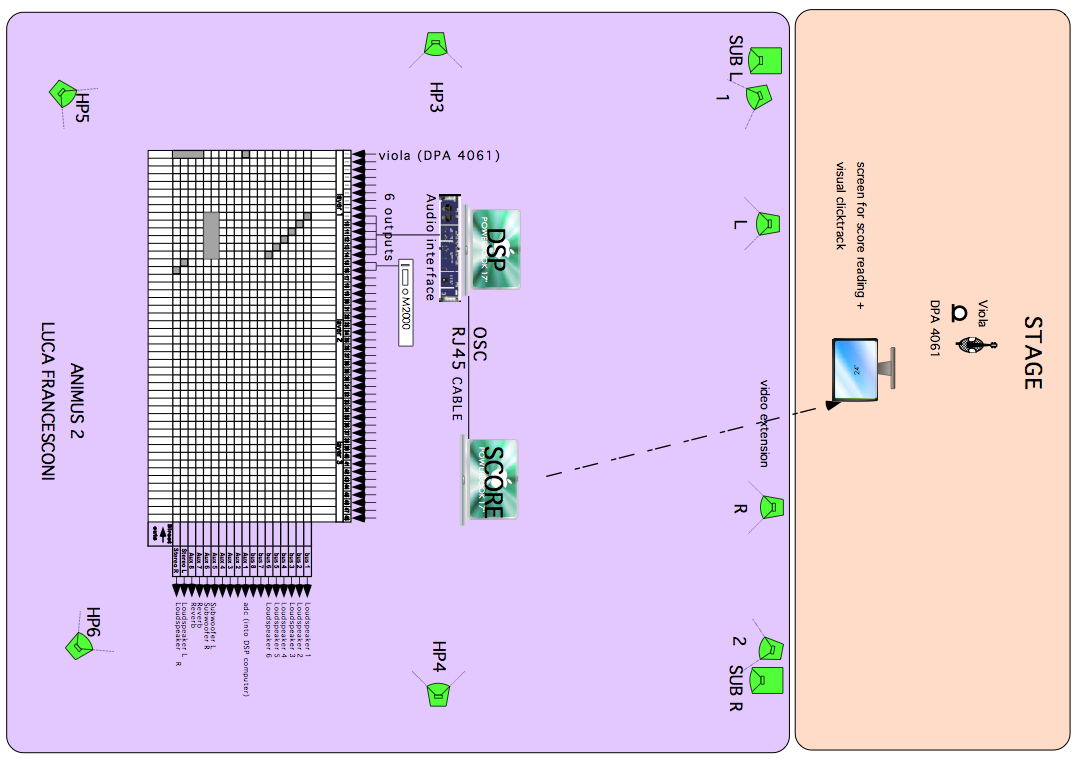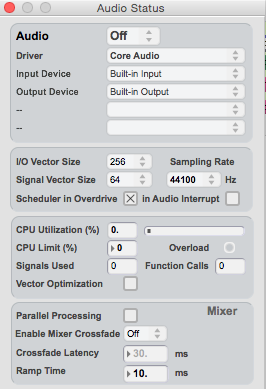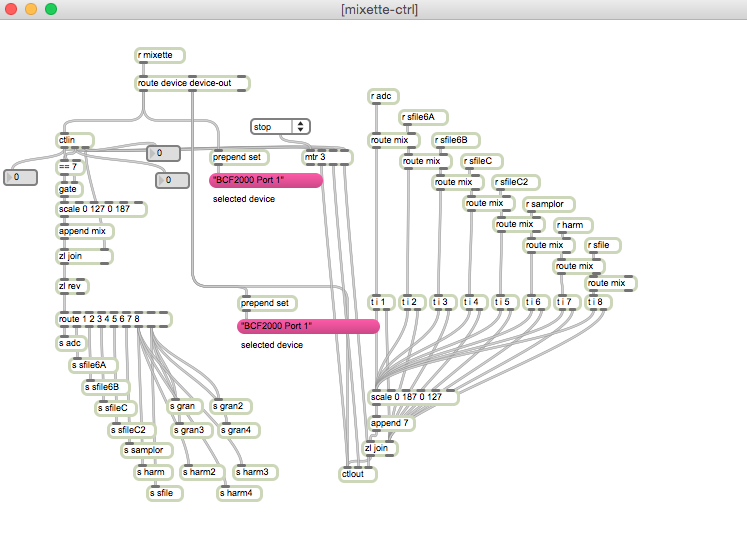Table of contents
Documentation date: 30 septembre 2015
Version state
Valid
Validation date: 3 mai 2018
Version documentalist
- meudic (Benoit.Meudic@ircam.fr)
Version realisation
- Benoit Meudic (Computer Music Designer)
Version length
20 mnUpgrade Motivation
Score display system upgraded to acrobat11.
Documentation clean up.
Not tested under Max 7 !
Comment
Not tested in concert, yet...
Other version(s)
Detailed staff
- alto
Electronic equipment list
Computer Music Equipment
-
1 MacBook Pro - Apple Laptops
(Apple)
main computer -
1 MacBook Pro - Apple Laptops
(Apple)
laptop display -
1 RJ 45 Cable - Cable
for laptops ethernet connexion -
1 Cable - Cable
vga for screen -
2 Max 6 - Max
(Cycling74)
-
1 ftm - Library
(Ircam)
-
1 Fireface 800 - Sound Board
(RME)
-
1 BCF 2000 - MIDI Mixer
(Behringer)
Audio Equipment
-
1 DPA 4021 - Condenser Microphones
(DPA)
for viola -
6 Loudspeaker - Loudspeakers
-
1 DM1000 - Digital Mixers
(Yamaha)
-
1 Lexicon 300 - Effects Processor
(Lexicon)
for amplification
Video
-
1 Screen - Screen
for instrumentist
Work related information
Premiere
- 14 juin 2007, Paris, Ircam, Festival Agora
Publisher :
- Ricordi
Realisation
- Benoît Meudic
Work length
- 15 mn
Useful links on Brahms
- Animus II pour alto et électronique (2007), 15mn
- Luca Francesconi
| File | Author(s) | Comment | |
|---|---|---|---|
| Download [168,1 Kio] | Setup Animus2.pdf | ||
| Download [3,6 Mio] | Score ANIMUS2 DEF.pdf | Luca Francesconi | manuscript |
| Download [605,2 Mio] | Patch max patches | Benoit Meudic | |
| Download [42,3 Mio] | Simulation files rec-munich-alto.aif.zip | recording of the Munich concert |
Instructions
Audio setup

Software presentation
The electronic part of Animus II is based upon soundfiles with a click-track all along the piece and real-time treatments on the viola sound.
The soundfiles are played by 4 players, two 6-channels players (sfile6A and sfile6B), and two stereo (sfileC and sfileC2 which is panned on 4 outputs).
Real-time treatments are realized with sampler, granulator, harmonizer and spatialisation modules.
The instrumentist follows a visual click-track in order to synchronise itself with the electronic part. The score is displayed with the click-track on a screen on stage. The score pages are turned automatically by the click-track. The display is done by a slave computer which is linked to the main computer by an ethernet connection.
A control surface should be used in order to mix the electronic treatments and the soundfiles (see faders mapping below).
SCORE/CLICK-TRACK DISPLAY:
installation:
Warning: the fullpath of the folder 'animusII-laptop' should not have any space, otherwise the shell scripts for score display will not run.
Copy the folder 'animusII-laptop' on the hard disk of the computer that displays the score and the click-track.
Launch max/msp and open the file 'animusII-laptop'.
Initialisation of the laptop display:
Instal "Adobe Reader XI Installer.pkg » (the installer is in the folder "animusII/animusII-laptop/").
Open the score 'ANIMUS2 DEF.pdf'
Open the patch animusII-laptop-800*600 in max.
Adapt the pdf size and the max patches to fit the entire screen.
Choose a manual ip adress for the computer and connect it to the main computer with an ethernet cable.
The page turns are automatically made by the click-track. Control commands (go to first page '1page', go to next page 'nextp' and go to previous page 'prevp') are send as osascript commands to the the shell object in max. The corresponding scripts are in the folder 'animusII-laptop'. If you use a different version of acrobat then you should adapt the scripts (1page.scpt, Pagesuivante.scpt and Pageprecedente.scpt) to the menus if they differ from acrobat 11.0.10. (Note: you may have to authorize external control to acrobat in System Preferences > Security & Privacy > Privacy > Accessibility)
MAIN COMPUTER:
installation:
- Copy the folder 'animusII-max' on the hard disk of the main computer.
- Launch max/msp, and select this folder (and only this one) in the 'file preferences' menu of max/msp.
- You need to use ftm 'FTM.2.5.0.BETA.20-Max5' to play the click-track. This library is provided in the folder 'animusII/animusII-max/externals. Check that ftm is correctly installed.
- The audio status should be set to 256 for I/O Vector Size, 64 for Signal Vector Size, 44100 for sampling rate, overdrive on and audio interrupt off :

(Be careful with the affectation of the sound driver. If vector size is at 0, the spat library will crash the patch at opening.)
- Open the file 'animusII' in max-msp.
Patch presentation:

The concert patch is made of:
- Top right: interface for events triggering and click-track playing. Events are represented by a number corresponding to the bar number reported in the instrumental score. The highlighted number corresponds to the next event that will be triggered. During rehearsal, you can play click-track from any point in the score : select the bar/beat in the click-track panel, then start click-track).
- Top middle: main sub-patchers (audio, midi, libraries, events counter, reset, matrix connections).
- Bottom: live mixing faders.
Inputs/Outputs:
- 1 input for the alto.
- 6 outputs for live electronics and soundfiles (dac 1/6 resp. on loudspeakers 1, 2, 3, 4, 5 and 6). The position of the loudspeakers is detailed in figure ‘Animus2.pdf’.
Initialisation in max/msp:
To initialize the patch:
1. Click on '1-load files'

2. Click on '2-config' (figure 'midi-config') and select the midi input/output of 'mixette' in order to configure your MIDI setup for the control surface (for mixing of adc, sfiles, samplor, harm and gran). You can access the routing of midi channels by clicking on 'mixette' (see picture below).

Choose a manual ip adress for the computer and provide the ip adress of the laptop displaying the score and the click-track.
Save the main patch to save the configurations.
3. click on '3-init' and wait for the message 'ok bang' in the max message window.
The bar/beat position on the displaying computer should automatically be set to '-2 1'. If not, check the udp connection between the two computers.
4. turn DSP on
Midi faders mapping:
Midi controller #7 is used for the control faders :
- channel 1, adc level
- channel 2, sfile6A
- channel 3, sfile6B
- channel 4, sfile6C
- channel 5, sfile6C2
- channel 6, samplor
- channel 7, harmonizers
- channel 8, sfile/granulators.
Performance instructions
Initialise the max/msp patch, turn the dac on.
Start the click-track in max. The click-track starts 2 bars before bar 1.
On bar 1 beat 1, you have to manually trigger a soundfile (there is a bang button in the main patch for that). The important thing is to be synchronous with the instrumentist, not with the click-track.
Then, follow the soundfiles and the electronic treatments (harmonizer, samplor, granulator). The electronic should be at least as loud as the instrumentist.
Practice instructions
For practicing, the instrumentist can use the file AnimusII-click.mp4 in the folder 'for-practice'. This file is a video that displays the click-track, and plays the soundfiles.
During rehearsal, you can open the gate of the click-track (right middle part of the patch) in order to play the soundfiles from the correct position.
Then you can start from any bar: just select the bar from which to start (above), turn the page of the score at the right position, and play click-track.
© IRCAM

This documentation is licensed under a Creative Commons Attribution-NonCommercial-NoDerivatives 4.0 International License.
Program note
Animus II est les deuxième chapitre d'une série d'explorations sonores par des techniques digitales. Dans chaque pièce, un soliste se confronte à l'ordinateur : dans [work:8685][Animus I], c'était le trombone et ici l'alto – Animus I paraîtra sur un CD monographique de Luca Francesconi dans la collection « Sirène » de l'Ircam et de l'Ensemble intercontemporain édité chez Kairos (sortie prévue en novembre 2007). Ces deux pièces sont des commandes de l'Ircam.
C'est une nouvelle recherche de particules de lumière dans une matière usée, saturée, post-digitale.
Avec l'ordinateur, on explore d'abord ces lueurs puis les connexions musicales et vitales entre rythmes et couleurs. Mais cette tekmè n'est peut-être plus une alliée et démolit les limites de notre intimité, nous envahissant.
La pièce est née d'un projet avec Garth Knox il y a quinze ans : alors que nous écoutions le solo d'alto du [work:8696][Quatuor n° 3] que nous étions en train d'enregistrer à la Radio de Cologne, nous avons pensé qu'il serait intéressant de développer ce fragment en œuvre à part entière, presqu'un « concerto » pour alto et électronique. Le rôle de cet élément sert de moteur générateur de fonctions compositionnelles et articulatrices mais aussi de fonctions expressives, et investit toute la pièce d'une dimension rituelle, d'une « tension sémantique ».
Luca Francesconi, Agora 2007
Version documentation creation date: 30 septembre 2015 09:12, update date: 6 mai 2021 15:09